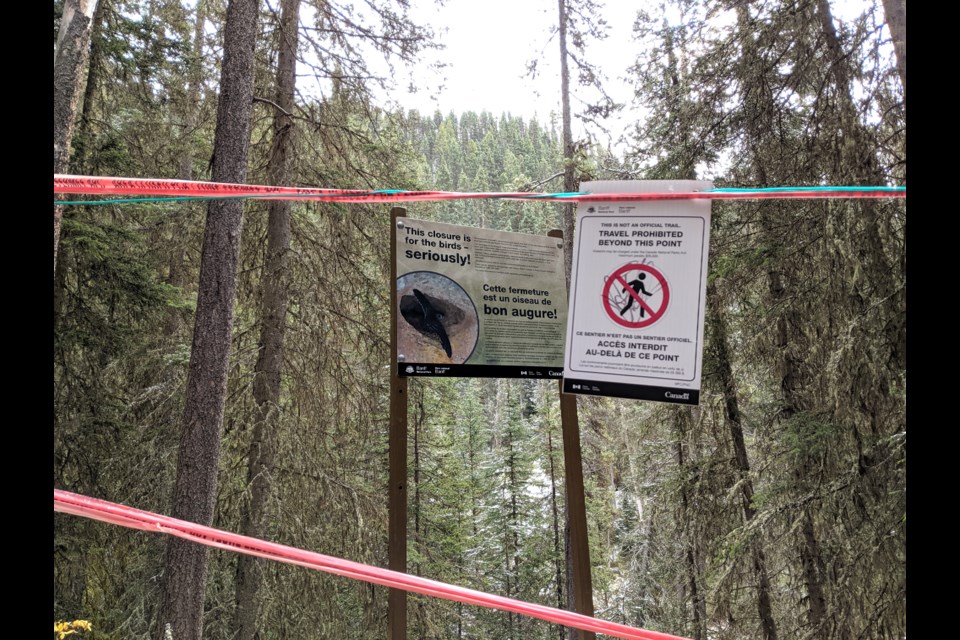BANFF – Nesting black swifts, which are on the brink of extinction in North America, are spreading some hope in Banff National Park this year.
Parks Canada officials say there are at least three pairs of the endangered birds nesting in Johnston Canyon – the only known place where the species nests in the park and one of only a few known locations in Alberta.
“This is actually more nesting activity than we’ve had in the past 16 years,” said Daniella Rubeling, the visitor experience manager for Banff National Park.
“Last year we had only one nesting pair. Three nesting sites may not seem like much, but it is an important three-fold increase for us to have seen here.”
The black swift, which is designated an endangered species under the Species At Risk Act (SARA) because of dramatic declines in population of more than 50 per cent in 40 years, is one of only two land birds in Canada to lay just one egg.
According to the Committee on the Status of Endangered Wildlife in Canada (COSEWIC), there are fewer than 100 known nest sites in Canada and the United States.
Counts of breeding birds at Johnston Canyon show numbers have varied from the first record in 1919. Peak numbers were in 1981 and 1982 when there were 12 nests.
The migratory birds like to nest in shallow pockets or ledges along cliff walls, often associated with waterfalls like Johnston Canyon, and typically return to the same nest year after year.
Both parents care for and feed the chick until it is ready to fly, which may take up to almost 50 days.
Rubeling said there is no confirmation yet that the chicks have hatched, but Parks Canada wildlife crews are checking regularly for any sign of activity.
“It’s really difficult to get a good view of what’s going on in the nests other than seeing the adults coming and going,” she said. “So we don’t know yet if they’ve hatched, but stay tuned.”
Parks Canada officials say it’s hard to attribute the increase in nesting pairs at Johnston Canyon to anything specific, but noted they have put in place many measures to protect the bird and visitation numbers are much lower this year due to COVID-19.
Typically one of the busiest tourist hotspots in the park pre-pandemic, Rubeling said there can be thousands of people a day on the trail during the peak summer season.
However this year, she said the eastern portion of the Bow Valley Parkway continues to be closed to public vehicles, meaning far fewer visitors.
“It’s still very popular, but we’re seeing about one tenth of the visitation on the trail right now, so that definitely could have some impact,” she said. “Also, if there are less people, there are less people who would go down into the canyon.”
Since 2018, Parks Canada has banned access to the area where the black swifts nest in Johnston Canyon between April/May and Nov. 15 each year to protect the troubled species.
In addition, numerous signs remind visitors to stay on the main designated trail, and cable fencing has more recently been installed to keep people out. There are also more staff present this year to educate people.
National park wardens charged 77 people last year for breaking the off-trail closure in place to protect the at-risk birds, and so far this year another seven people have been charged.
People charged with breaking the law are required to appear in court and could face fines of up to $25,000.
“We’re seeing the measures that we’ve put in place seem to be working in terms of protecting the birds, and in reducing some of the numbers of intrusions and violations of that restricted activity order,” Rubeling said.
It was also exciting to see the birds nest two weeks earlier than usual this year, Rubeling said, despite the late start to spring.
“That’s really giving them a much better opportunity to have young, feed them, get them nice and strong and healthy before migrating in the fall,” she said.
According to COSEWIC, the population size of black swifts is hard to determine, but is estimated at 15,000 to 60,000 mature individuals.
Canada is home to about 80 per cent of the North American population with most found in British Columbia and only 0.1 per cent in Alberta.
The causes for their population decline are not fully understood, however, scientists believe it may have something to do with the availability of food because they specialize on a diet of flying insects. Also, black swifts may be a sensitive indicator for climate change because their waterfall nesting sites are likely to be affected by decreased snowpacks and glacial melt.
The birds, recognized by their black plumage, streamlined body and long, curved and pointy wings and the only North American swift with a notched tail, stay in Banff from late spring until fall.
According to COSEWIC scientists, birds come to their northern breeding areas in B.C. in late April to early June, peaking in mid-to late May or mid-June in Alberta.
Their departure dates for leaving breeding areas to migrate southward vary from late August to early October in B.C., to mid-September for Alberta. Those leaving earlier would most likely be failed breeders.
Rubeling said the increase in nesting black swift pairs is a “good news story.”
“The take home is that people can help,” she said. “They have the ability to contribute to the success of an endangered species by staying on the trail and being mindful of those closures and restricted areas.”
To report black swift nesting activity, or if you witness anyone illegally disturbing a black swift and/or its nest, call Banff emergency dispatch at 403-762-1470.




